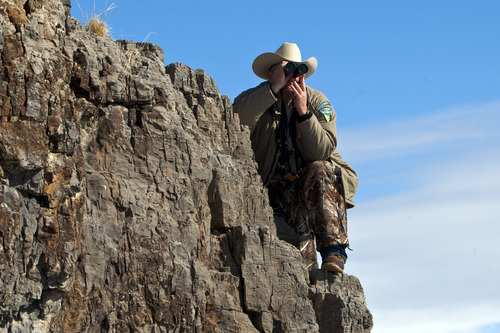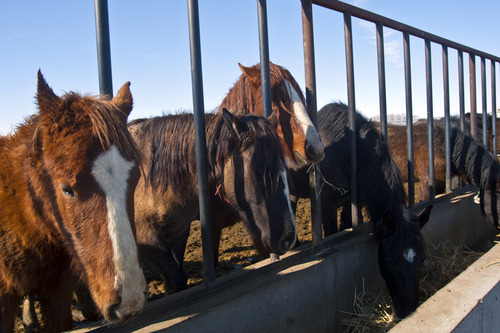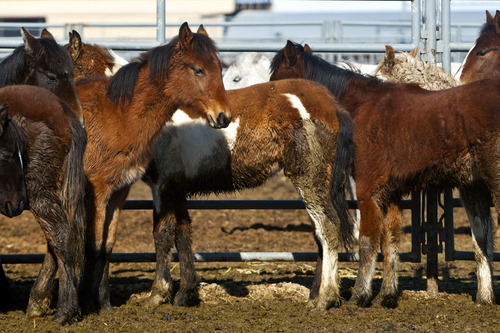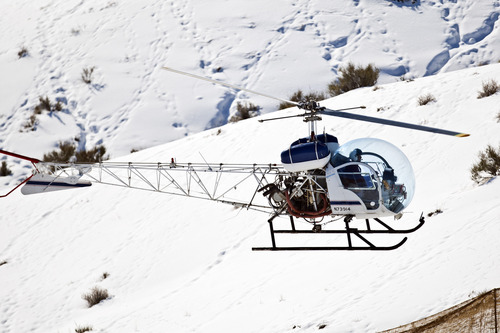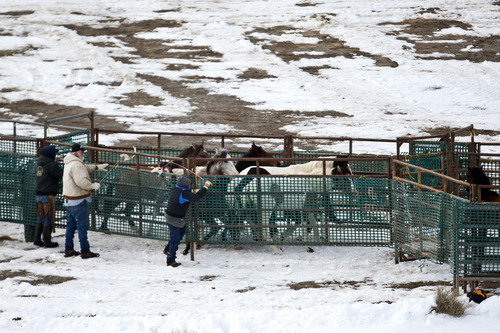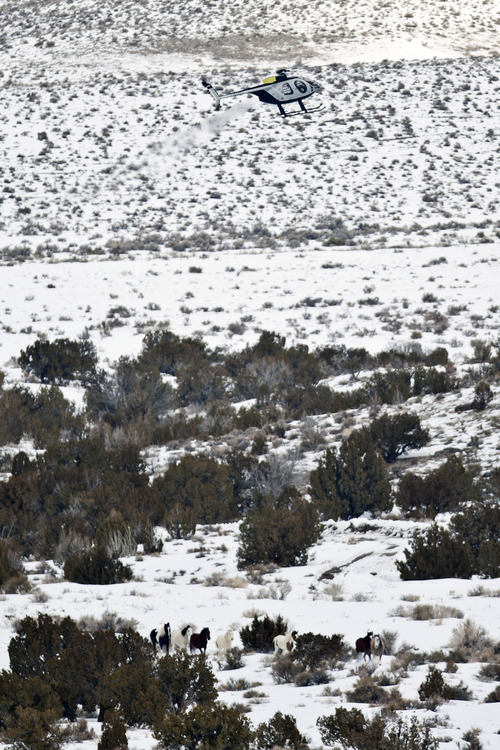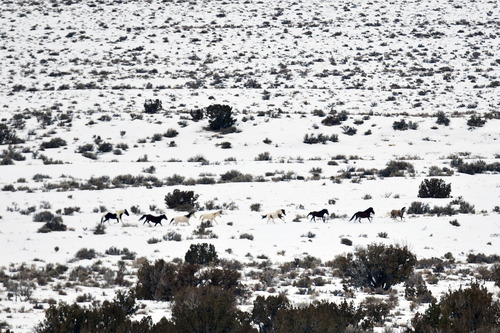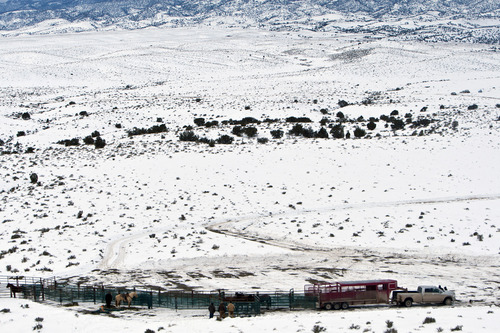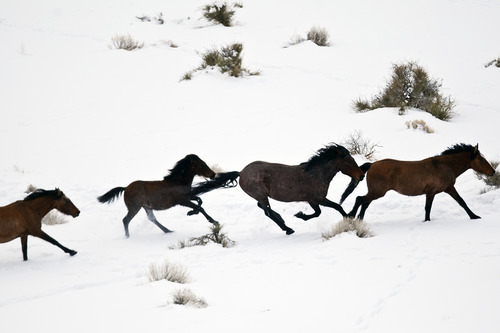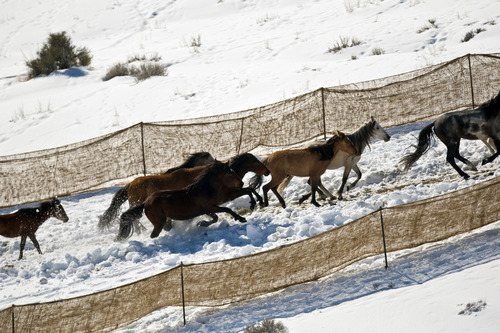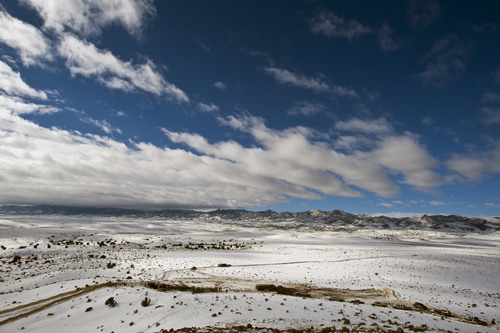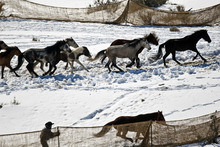This is an archived article that was published on sltrib.com in 2013, and information in the article may be outdated. It is provided only for personal research purposes and may not be reprinted.
Delta • The horses appear over a rise in the Whirlwind Valley, their hooves breaking through a blanket of crusty snow as they run north. The pace alternates between a gallop and canter as they trail a stallion in single file. A gray mare is pregnant and a foal appears to limp as it struggles to keep up.
Behind the band of wild horses looms a helicopter, arcing back and forth, urging the dozen animals toward a trap that will change their lives. The lucky ones will be adopted, but many will spend the rest of their days in government-sponsored captivity. These are the last moments the foals and yearlings will spend with their mares.
Thursday's scene was part of the Bureau of Land Management's roundup of the Swasey herd in Utah's west desert. The area is a 120,000-acre patch named for 9,678-foot Swasey Peak, 50 miles west of Delta. After four days, BLM contractor Cattoor Livestock Roundup Co. completed the gather, capturing 257 of the 350 horses that had roamed this piece of desert.
None was injured, BLM said, although a female yearling got stuck for a short time between the bars of a pen at BLM's corrals in Delta. On Saturday, nearly 100 adults were returned to the Swasey herd's designated range after the mares were treated with a two-year contraceptive.
The Swasey roundup is the last of several in BLM's nine-month gather season, which pulled 3,500 horses and burros off public lands. That's almost 10 percent of the 36,000 estimated to roam 10 Western states. Hundreds have returned to the range, however, and the freed mares are all treated with contraceptives.
The Interior Department's wild horse program has been mired in controversy for years, with critics calling it an unnecessary, and sometimes inhumane misuse of tax dollars. But the BLM contends pulling some off the range is best for horses, even if it means keeping nearly 50,000 on ranches.
Observing Thursday's gather were members of a group that advocates keeping horses on the range and high standards of safety and horse health during captures. They weren't about to endorse federal horse policies, but they praised the skill of Cattoor's pilots and BLM's management of this particular roundup — at least the parts they could see.
"They have come a long way from how they used to do it," said Lisa Friday, a member of the Cloud Foundation who has adopted more than 50 wild horses. "I think it's because of the visitors and the bad publicity."
Last week's roundup comes at a time when Interior, confronted with evidence of past and ongoing abuses, is strengthening treatment guidelines for roundups and limiting the number of horses sold to individuals to keep them out of the hands of "kill buyers" and slaughterhouses. Federally protected, wild horses cannot legally be hunted or shipped for slaughter.
Now, activists aren't the only ones watching.
Last week Rep. Raul Grijalva, D-Ariz., led a group of 21 congressmen in calling on Interior Secretary Ken Salazar to explain why frequent roundups are a humane and fiscally sound way of managing wild horses. Two-thirds of the $75 million the BLM spends on the program goes toward putting horses in captivity.
"We need a long-term, sustainable plan, not piecemeal rule changes," Grijalva said in a media statement. "This is not a right-left political issue, it's a question of good governance."
Horse herds can double in size every four to five years, leaving the range damaged and the animals sick from thirst and hunger, BLM says. Removing animals is the most humane way to protect BLM's 170 herd management areas, the agency maintains. Utah has about 3,000 horses and burros in 19 areas.
The trap site for Thursday's roundup was staged in the form of a V-shaped jute fence set against a knoll. As the mustangs entered the trap's broad mouth, wranglers released a saddle-less domesticated horse, called a "Judas horse," that its wild cousins followed up the funnel.
Thursday's gather netted 94 horses. Although saddened by the spectacle of wild animals losing their freedom, Cloud founder Ginger Kathrens and her associates were pleased with how the helicopter pilot kept a respectful distance from the horses and did not rush them up the snow-choked rise toward the chute connecting the trap with trailers. Not once did they see a wrangler wield a "hot shot," an electric cattle prod whose overuse has come under fire.
But the young horses were quickly separated from the adults in the chute and one foal tried to leap a gate as its bandmates were loaded, leaving it behind.
"What they value most is freedom and family," said Lauryn Wachs, a Cloud member photographing the roundup. "Today they lose both."
Wild horses and burros
Under the Wild Free-Roaming Horses and Burros Act of 1971, wild horses and burros are declared to be "living symbols of the historic and pioneer spirit of the West."
Under the law, the BLM and U.S. Forest Service manage and protect herds in their respective jurisdictions, while also working to maintain rangeland health. The BLM's Wild Horse and Burro Program has adopted out more then 230,000 wild animals since 1971.
For more information on how to adopt a wild horse or burro, go to http://on.doi.gov/XcgdjB.


